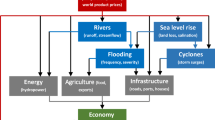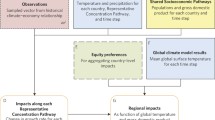Abstract
As economic and emissions scenarios assume convergence of per capita incomes, they are sensitivity to the exchange rate used for international comparison. Particularly, developing countries are project to grow slower with a purchasing power exchange rate than with a market exchange rate.
Different exchange rates may lead to scenarios with very different per capita incomes. However, these scenarios also assume convergence of energy intensities, which at least partly offsets the income effect, so that scenarios with different exchange rates would differ less in greenhouse gas emissions. Differences become smaller still if atmospheric concentrations and global warming is considered. However, differences become larger again if one considers the costs of meeting a certain stabilisation target, as the gap between baseline and target is more sensitive to the exchange rate used than the baseline itself. Differences also grow larger if one looks at climate change impacts, which are determined not just by climate change but also by development. The sensitivity to the exchange rate is purely due to imperfect data, imperfect statistical analysis of data, a crude spatial resolution, and imperfect models.
Similar content being viewed by others
References
Barro, R. J. and Sala-i-Martin, X.: 1995, Economic Growth. MIT Press, Cambridge.
Batjes, J. J. and Goldewijk, C. G. M.: 1994, The IMAGE 2 Hundred Year (1890–1990) Database of the Global Environment (HYDE), RIVM, Bilthoven, 410100082.
Bruce, J. P.: 1995, ‘Impact of climate change’, Nature 377, 472.
Bruce, J. P.: 1996, ‘Purpose and function of IPCC’, Nature 379, 108–109.
Castles, I.: 2004, ‘Climate work based on unsound economics’, Australian Financial Review (Feb 7{th}).
Castles, I. and Henderson, D.: 2003a, ‘The IPCC emission scenarios: An economic-statistical critique’, Energy and Environment 14(2/3), 159–185.
Castles, I. and Henderson, D.: 2003a, ‘Economics, emission scenarios and the work of the IPCC’, Energy and Environment 14(4), 415–435.
Cline, W. R.: 1992, The Economics of Global Warming. Institute for International Economics, Washington, D.C.
Courtney, R. S.: 1996, ‘Purpose and function of IPCC’, Nature 379, 109.
Dixon, P. B. and Rimmer, M. T.: 2004, The Convergence Hypothesis in the Context of Multi-Country Computable General Equilibrium Modelling, Report to the Department of Treasury and the Australian Greenhouse Office, Centre of Policy Studies, Monash University.
Economist: 2003a, Hot Potato. The Intergovernmental Panel on Climate Change had better check its calculations (Feb 13{th}).
Economist: 2003b, Hot Potato Revisited. A Lack-of-Progress Report on the Intergovernmental Panel on Climate Change (Nov 6{th}).
Economist: 2004, Measuring Economies: Garbage In, Garbage Out (May 27{th}).
Fankhauser, S. and Tol, R. S. J.: 1995, A Recalculation of the Social Costs of Climate Change – A Comment, The Ecologist, Newton.
Fankhauser, S. and Tol, R. S. J.: 1996, ‘Climate change costs – recent advancements in the economic assessment’, Energy Policy 24(7), 665–673.
Fankhauser, S., Tol, R. S. J., and Pearce, D. W.: 1998, ‘Extensions and alternatives to climate change impact valuation: On the critique of IPCC working group III's impact estimates’, Environment and Development Economics 3, 59–81.
Fankhauser, S.: 1994, ‘Protection vs. retreat – the economic costs of sea level rise’, Environment and Planning A 27, 299–319.
Fankhauser, S., Tol, R. S. J., and Pearce, D. W.: 1997, ‘The aggregation of climate change damages: A welfare theoretic approach’, Environmental and Resource Economics 10, 249–266.
Fankhauser, S. and Tol, R. S. J.: 1997, ‘The social costs of climate change: The IPCC second assessment report and beyond’, Mitigation and Adaptation Strategies for Global Change 1, 385–403.
Grubb, M. J.: 1996, ‘Purpose and function of IPCC’, Nature 379, 108.
Grübler, A., Nakicenovic, N., Alcamo, J., Davis, G., Fenhann, J., Hare, B., Mori, S., Pepper, B., Pitcher, H., Riahi, K., Rogner, H.-H., Lebre La Rovere, E., Sankovski, A., Schlesinger, M., Shukla, R. P., Swart, R., Victor, N., and Jung, Tae Young: 2004, ‘Emissions scenarios: A final response’, Energy and Environment 15(1), 11–24.
Hammitt, J. K., Lempert, R. J., and Schlesinger, M. E.: 1992, ‘A sequential-decision strategy for abating climate change,’ Nature 357, 315–318.
Heston, A., Summers, R., and Aten, B.: 2002, Penn World Table Version 6.1, Center for International Comparisons at the University of Pennsylvania (CICUP), October.
Holtsmark, B. J. and Alfsen, K. H.: 2004a, On the Question of PPP Corrections to the SRES Scenarios, Policy Note 2004-01, CICERO, Oslo.
Holtsmark, B. J. and Alfsen, K. H.: 2004b, ‘The use of PPP or MER in the construction of emission scenarios is more than a question of metrics,’ Climate Policy 4(2).
Holtsmark, B. J. and Alfsen, K. H.: 2005, ‘PPP correction of the IPCC emission scenarios – does it matter?’, Climatic Change 68(1/2), 11–29 (also: Discussion Paper 366, Statistics Norway, Oslo).
IPCC: 2003, IPCC Press Information on AR4 and Emissions Scenarios ({http://www.ipcc.ch/ press/pr08122003.htm}).
Kattenberg, A., Giorgi, F., Grassl, H., Meehl, G. A., Mitchell, J. F. B., Stouffer, R. J., Tokioka, T., Weaver, A. J., and Wigley, T. M. L.: 1996, ‘Climate models – projections of future climate’, in Houghton, J. T. et al. (eds.), Climate Change 1995: The Science of Climate Change – Contribution of Working Group I to the Second Assessment Report of the Intergovernmental Panel on Climate Change, 1st ed., Cambridge University Press, Cambridge, pp. 285–357.
Leggett, J., Pepper, W. J., and Swart, R. J.: 1992, “Emissions scenarios for the IPCC: An update,” in Houghton, J. T., Callander, B. A., and Varney, S. K. (eds.), Climate Change 1992 – The Supplementary Report to the IPCC Scientific Assessment, 1st ed., vol. 1 Cambridge University Press, Cambridge, pp. 71–95.
Maier-Reimer, E. and Hasselmann, K.: 1987, ‘Transport and storage of carbon dioxide in the ocean: An inorganic ocean circulation carbon cycle model’, Climate Dynamics 2, 63–90.
Manne, A. S. and Richels, R. G.: 2003, Market Exchange Rates or Purchasing Power Parity: Does the Choice Make a Difference in the Climate Debate? AEI-Brooking Joint Center for Regulatory Studies Working Paper 03-11 ({http://www.aei-brookings.org/admin/authorpdfs/page.php?id = 290}).
Manne, A. S., Richels, R. G., and Edmonds, J. A.: forthcoming, ‘Market exchange rates or purchasing power parity: Does the choice make a difference to the climate debate?’, Climatic Change.
Masood, E.: 1995, ‘Developing countries dispute use of figures on climate change impact’, Nature 376, 374.
Masood, E. and Ochert, A.: 1995, ‘UN climate change report turns up the heat’, Nature 378, 119.
McKibbin, W. J., Pearce, D., and Stegman, A.: 2004, Long Run Projections for Climate Change Scenarios, Working Papers in International Economics {1.04}, Lowly Institute for International Policy, Sydney.
Mendelsohn, R., Morrison, W., Schlesinger, M. E., and Andronova, N. G.: 2000, ‘Country-specific market impacts of climate change’, Climatic Change 45, 553–569.
Meyer, A. and Cooper, T.: 1995, A Recalculation of the Social Costs of Climate Change, The Ecologist, Newton.
Meyer, A.: 1995, ‘Costing calamity’, New Scientist.
Meyer, A.: 1995, ‘Economics of climate change’, Nature 378, 433.
Michaels, P. (ed.) 2003, ‘Bad math’, World Climate Report 13(10). http://www.co2andclimate.org
Miketa, A. and Mulder, P.: forthcoming, ‘Energy-productivity across developed and developing countries in 10 manufacturing sectors: Patterns of growth and convergence’, Energy Economics.
Nakicenovic, N.: 2004, Presentation at the EMF Workshop on MER v PPP Exchange Rates and Climate Policy, Stanford, February 19–20.
Nakicenovic N. and Swart, R. J.: 2000, Emissions Scenarios 2000 – Special Report of the Intergovernmental Panel on Climate Change, Cambridge University Press, Cambridge.
Nakicenovic, N., Grübler, A., Gaffin, S., Jung, T. T., Kram,T., Morita, T., Pitcher, H., Riahi, K., Schlesinger, M., Shukla, P. R., Van Vuuren, D., Davis, G., Michaelis, L., Swart, R., and Victor, N.: 2003, ‘IPCC SRES revisited: A response’, Energy and Environment 14(2/3), 187–214.
Nature: 1995, ‘Global warming rows’, Nature 378, 322.
O'Riordan, T.: 1997, ‘Review of climate change 1995 – economic and social dimension’, Environment 39(9), 34–39.
Pant, H. M. and Fisher, B. S.: 2004, PPP versus MER: Comparison of Real Income Across Nations, Conference Paper 04.3, ABARE, Canberra.
Pearce, D. W.: 18-12-1995, ‘Valuing Climate Change’, Chemistry {&} Industry 1024.
Pearce, F.: 1995, ‘Global row over value of human life’, New Scientist August 19, 7.
Pearce, F.: 1995, ‘Price of Life Sends Temperatures Soaring’, New Scientist April 1, 5.
Romer, D.: 1996, Advanced Macroeconomics, McGraw-Hill, New York.
Shine, K. P., Derwent, R. G., Wuebbles, D. J., and Morcrette, J.-J.: 1990, ‘Radiative forcing of climate’, in Houghton, J. T., Jenkins, G. J., and Ephraums, J. J. (eds.), Climate Change – The IPCC Scientific Assessment, 1 edn, vol. 1 Cambridge University Press, Cambridge, pp. 41–68.
Sundaraman, N.: 1995, ‘Impact of climate change’, Nature 377, 472.
Tol, R. S. J.: 1995, ‘The damage costs of climate change toward more comprehensive calculations’, Environmental and Resource Economics 5, 353–374.
Tol, R. S. J.: 1996, ‘The damage costs of climate change towards a dynamic representation’, Ecological Economics 19, 67–90.
Tol, R. S. J.: 1997), ‘The social cost controversy: A personal appraisal’, in A. Sors et al. (eds.), Proceedings of the International Symposium Prospects for Integrated Environmental Assessment: Lessons Learnt from the Case of Climate Change, European Commission DG12, Brussels, pp. 35–42.
Tol, R. S. J.: 1999, ‘Kyoto, efficiency, and cost-effectiveness: Applications of FUND’, Energy Journal Special Issue on the Costs of the Kyoto Protocol: A Multi-Model Evaluation, pp. 130–156.
Tol, R. S. J.: 1999, ‘Safe policies in an uncertain climate: An application of FUND’, Global Environmental Change 9, 221–232.
Tol, R. S. J.: 1999, ‘Spatial and temporal efficiency in climate change: Applications of FUND’, Environmental and Resource Economics 14(1), 33–49.
Tol, R. S. J.: 1999, ‘The marginal costs of greenhouse gas emissions’, Energy Journal 20(1), 61–81.
Tol, R. S. J.: 1999, ‘Time discounting and optimal control of climate change – an application of FUND’, Climatic Change 41(3/4), 351–362.
Tol, R. S. J.: 2001, ‘Equitable cost-benefit analysis of climate change’, Ecological Economics 36(1), 71–85.
Tol, R. S. J.: 2002, ‘Estimates of the damage costs of climate change – Part 1: Benchmark estimates’, Environmental and Resource Economics 21, 47–73.
Tol, R. S. J.: 2002, ‘Estimates of the damage costs of climate change – Part II: Dynamic estimates’, Environmental and Resource Economics 21, 135–160.
Tol, R. S. J.: 2002, ‘Welfare specifications and optimal control of climate change: An application of fund’, Energy Economics 24, 367–376.
Tol, R. S. J.: 2003, ‘Is the uncertainty about climate change too large for expected cost-benefit analysis?’, Climatic Change 56, 265–289.
Tol, R. S. J. and Dowlatabadi, H.: 2001, ‘Vector-borne diseases, development {&} climate change’, Integrated Assessment 2, 173–181.
Tol, R. S. J. and Fankhauser, S.: 1998, ‘On the representation of impact in integrated assessment models of climate change’, Environmental Modeling and Assessment 3, 63–74.
Tol, R. S. J., Heintz, R. J., and Lammers, P. E. M.: 2003, ‘Methane emission reduction: An application of FUND’, Climatic Change 57, 71–98.
Tol, R. S. J. and Verheyen, R.: 2004, ‘State responsibility and compensation for climate change damages – a legal and economic assessment’, Energy Policy 32, 1109–1130.
Van Vuuren, D.: 2004, Presentation at the EMF Workshop on MER v PPP Exchange Rates and Climate Policy, Stanford, February 19–20.
WRI: 2000, World Resources 2000–2001 People and Ecosystems, World Resources Institute, Washington, D.C.
Author information
Authors and Affiliations
Rights and permissions
About this article
Cite this article
Tol, R.S.J. Exchange Rates and Climate Change: An Application of Fund . Climatic Change 75, 59–80 (2006). https://doi.org/10.1007/s10584-005-9003-4
Received:
Revised:
Accepted:
Published:
Issue Date:
DOI: https://doi.org/10.1007/s10584-005-9003-4




